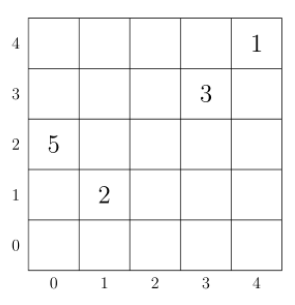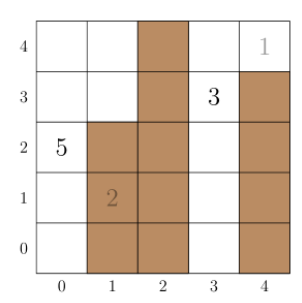IOI '22 P1 - Catfish Farm
View as PDFBu Dengklek owns a catfish farm.
The catfish farm is a pond consisting of an grid of cells.
Each cell is a square of the same size.
The columns of the grid are numbered from
to
from west to east and the rows are numbered from
to
from south to north.
We refer to the cell located at column
and row
of the grid (
,
) as cell
.
In the pond, there are catfish, numbered from
to
, located at distinct cells.
For each
such that
, catfish
is located at cell
, and weighs
grams.
Bu Dengklek wants to build some piers to catch the catfish.
A pier in column of length
(for any
and
) is a rectangle extending from row
to row
, covering cells
.
For each column, Bu Dengklek can choose either to build a pier of some length of her choice or to not build a pier.
Catfish (for each
such that
) can be caught if there is a pier directly to the west or east of it, and there is no pier covering its cell; that is, if
- at least one of the cells
or
is covered by a pier, and
- there is no pier covering cell
.
For example, consider a pond of size with
catfish:
- Catfish
is located at cell
and weighs
grams.
- Catfish
is located at cell
and weighs
grams.
- Catfish
is located at cell
and weighs
gram.
- Catfish
is located at cell
and weighs
grams.
One way Bu Dengklek can build the piers is as follows:
| Before the piers are built | After the piers are built |
|---|---|
 |
 |
The number at a cell denotes the weight of the catfish located at the cell.
The shaded cells are covered by piers.
In this case, catfish (at cell
) and catfish
(at cell
) can be caught.
Catfish
(at cell
) cannot be caught, as there is a pier covering its location, while catfish
(at cell
) can not be caught as there is no pier directly to the west nor east of it.
Bu Dengklek would like to build piers so that the total weight of catfish she can catch is as large as possible. Your task is to find the maximum total weight of catfish that Bu Dengklek can catch after building piers.
Implementation Details
You should implement the following procedure:
long long max_weights(int N, int M, std::vector<int> X, std::vector<int> Y, std::vector<int> W)
: the size of the pond.
: the number of catfish.
,
: arrays of length
describing catfish locations.
: array of length
describing catfish weights.
- This procedure should return an integer representing the maximum total weight of catfish that Bu Dengklek can catch after building piers.
- This procedure is called exactly once.
Example
Consider the following call:
max_weights(5, 4, {0, 1, 4, 3}, {2, 1, 4, 3}, {5, 2, 1, 3})
This example is illustrated in the task description above.
After building piers as described, Bu Dengklek can catch catfish and
, whose total weight is
grams.
As there is no way to build piers to catch catfish with a total weight of more than
grams, the procedure should return
.
Constraints
,
(for each
such that
)
(for each
such that
)
- No two catfish share the same cell.
In other words,
or
(for each
and
such that
).
Subtasks
- (3 points)
is even (for each
such that
)
- (6 points)
(for each
such that
)
- (9 points)
(for each
such that
)
- (14 points)
,
(for each
such that
)
- (21 points)
- (17 points)
- (14 points) There are at most
catfish in each column.
- (16 points) No additional constraints.
Sample Grader
The sample grader reads the input in the following format:
- line
:
- line
:
The sample grader prints your answer in the following format:
- line
: the return value of
max_weights
Attachment Package
The sample grader along with sample test cases are available here.
Comments
- Me after solving the problem and spending over 2 years on the implementation with too many bugs in my code to fix
Since the sample test case was improperly placed, it was moved, and all submissions were rejudged.